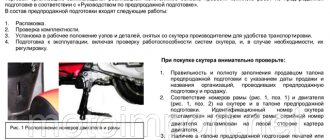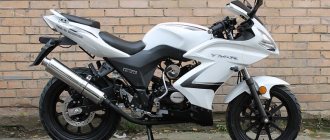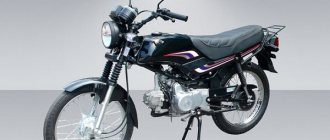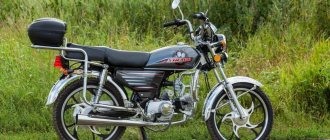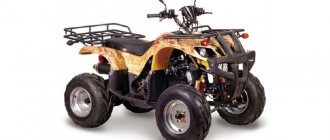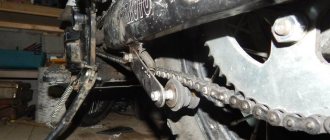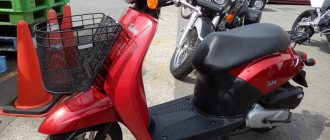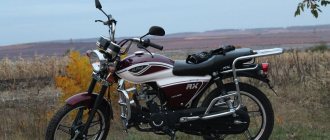The Chinese Yamasaki Scorpion motorcycle, at the first glance at it, evokes a strong feeling that you have already seen all this somewhere before. Even the name of the company itself, which clearly hints at the famous brands Yamaha and Kawasaki, does not sparkle with originality, let alone the products of this manufacturer? In addition, the hero of our article is, strictly speaking, a moped, not a motorcycle. However, it has different modifications, and, for example, the Yamasaki Scorpion 4 is also offered with a 125 cc engine instead of a 50 cc one. Yes, and there is enough tuning for it, and increasing the working volume of the piston, if desired, will not be difficult.
What's inside the Yamasaki Scorpion?
Despite the fact that this moped was and is produced in different modifications , they are all quite similar to each other. Most often on sale, and on the roads too, you can find the Yamasaki Scorpion 3. Like all other Scorpions, it is extremely simple - a 2-valve air-cooled engine , a carburetor, a 4-speed transmission , a disc brake in the front and a drum brake in the rear. The maximum speed of all Yamasaki Scorpion YM50 8A with 50 cc engines does not exceed 70 km/h , and fuel consumption is approximately 3 liters of AI-92 . The 125 cc versions of the Yamasaki Scorpion 4 are more interesting in this regard; they can accelerate to 100 km/h , at least according to the manufacturer. But the overall picture is still spoiled by the 4-speed gearbox. Fifth gear is really very lacking, and even with only four, you have to constantly switch between them. The gearbox does not operate smoothly - knocking, clanging, periodic jamming, but what did you want from an extremely budget and completely secondary budget craft?
are equipped with a kickstarter
in addition to the electric starter . The volume of the gas tank varies depending on the model - for example, for Scorpion 3 it is 12 liters , and for Scorpion 4 - as much as 18 , which provides it with up to 500 km of cruising range without refueling .
True, it will not be easy to withstand such a long journey on this moped - the hard seat, not very comfortable seating and the lack of even a hint of dynamics are unlikely to allow you to enjoy the ride. But the manufacturer has provided a windshield! True, it is not clear why, because at the speed that even the “top” Yamasaki Scorpion 4 is capable of reaching, the headwind is still not strong enough to create inconvenience for the driver. But the moped itself copes with this task perfectly!
Is the game worth the candle?
Is the game worth the candle?
27 Sep 2021, 11:28
Hello everyone!) Recently I became the proud owner of a two-wheeled horse (Yamasaki Scorpion 3 moped). So I’m ready to increase the cubic capacity (now it’s 72cc). There’s a lot of information on the Internet on how to switch from 50 to 72, from 72 to 110, etc. But there are very few reviews and comparisons of the “before and after” type, basically I start everything with these words: 50cc is not enough for you (72, 110, etc.) then I begin to describe in detail the procedure for increasing volume, and what happens after the transition and the feeling of increasing cubic capacity often remains behind the scenes. Since I’m not very versed in technology, I decided for myself that if I increase the cubic capacity, it will only be by replacing the entire engine, but that’s the question, is it worth it?! Calling the shops I found out this is what I found: Engine in Sat. 110cc 139FMB (152FMН) semi-automatic 4 front, the store offered 125cc Engine in Sat. 125cc 139FMB (152FMI) UNNUMBERED.
1. How will the speed dynamics change when setting 110 and 125? and will there be a noticeable difference between 72 and 110, 125? 2. The price of the issue is 17 thousand rubles, this is the price of the engine assembly (is it worth it?) 3. What does a numberless engine mean? 4. Comrades of the traffic police, how do they feel about engines 110 and 125 ? (after all, the 110 is even more or less like a 50cc, but the 125 didn’t seem like a 50cc at all to me, although I only saw it in pictures) 5. Are the 110 and 125cc also marked 50cc?
Source
Pros and cons of Yamasaki Skorion
Advantages
- Abundance of tuning . For example, the 50cc Yamasaki Scorpion YM50 8A, like its 125cc brother, can be easily converted into a 150cc bike. This, of course, will not turn them into a rocket, but their agility will noticeably increase.
- Low price . It won’t be easy to find something cheaper, but a used Scorpio can even be purchased for several tens of thousands of rubles.
- Versatility of spare parts and consumables. Almost everything you need can be picked up in any store that sells spare parts for Chinese scooters and motorcycles.
- Weight . Yamasaki Scoprion 3 or 4 weighs only about 100 kg, like their previous modifications. Physically, handling a moped is very easy.
Flaws
- Build quality . There are the most complaints about it - even on new mopeds, something regularly unscrews and falls off. To be fair, we note that this depends on the integrity of the particular dealer. Some of them still fine-tune the equipment before handing it over to the buyer.
- Too archaic transmission . KPP-4 in the 21st century - are you serious?
- Weak brakes . There is nothing to say about the rear “drum”, but even the front disc brake is of little use.
- Uncomfortable landing . The moped is clearly designed for compact Chinese, and not for physically larger Europeans.
- Extremely weak light from the headlight. On unlit roads at night you feel extremely insecure on the Yamasaki Scorpion, because the power of the headlight is comparable to that of a flashlight.
Reviews from Yamasaki Scorpion owners
A purely externally normal moped, but it’s not a ride yet. I’m not complaining, I bought a Yamasaki Scorpio 3 with a tuned piston, compared to the stock one it’s heaven and earth, but the small shoals that constantly come out really piss me off. The only thing that saves the situation is that spare parts are sold almost by weight, I bought a new carburetor for something like 1k rubles, the rest is just trifles. You can pour even sunflower oil into the engine, any kind of gasoline will eat and not choke. Igor, Solnechnogorsk, Yamasaki Scorpion 3 '2017.
I liked the Scorpio, I bought it recently, it’s just been run-in, no problems have arisen. The motorcycle is new, I bought it at the showroom, according to the documents it was 50cc, in fact it was 125, the traffic police slowed down - they didn’t find fault, there is enough category M license. Dynamics at 4/5, fifth gear would definitely not hurt. Alexander, Yaroslavl, Yamasaki Scorpion 4 '2019.
I sold it and forgot it, like a bad dream, I drove a little less than 5,000 km per season on this fiend from Chinese scammers. Instead of listing what broke on it during this time, it would be easier to remember what didn’t break on it. Plastic can be crushed by hand, there were short circuits twice, the only really reliable components are the engine and brakes. The transmission began to dull after 500 km. In general, it is better to run away from equipment with the Yamasaki nameplate like the bubonic plague. Sergey, Moscow, Yamasaki Scorpio YM50 8A '2017.
The author has never sat on any vehicle with a motor other than his own! So, the 2021 season ended with the engine packed and the bike in the trunk. Probably the logical solution would be to save some money and buy a category A license? But... I didn’t do that) So, first of all, I scattered the engine into pieces, washed it, removed any defects, and came to the conclusion that it was in perfect condition =( Well, it’s a PITY, of course, to throw away completely serviceable parts, but. I threw out the knee) Installed knee with 8mm increased travel. I increased the piston diameter from 39 to 54 mm by replacing the cylinder with a new one. I ground the piston cap, as well as the cylinder head chamber, just for beauty) In total, the volume increased to 113 cm, i.e. in two. But we know that it’s also in the head! The head was thoroughly redesigned. And when I say redesigned, I really mean redesigned) The cylinder head was sawed/built up by comrade Nebero at the stand)! Channels 21/18 (+3mm), valves 24/21 (+1 to the drain), 4 chamfers on the inlet, 3 on the exhaust, the drain channel from the 70cc cylinder head was completely reprofiled (110 was terribly blown, worse than the 70, a fellow tuner actually recommended it throw it away)
The body of the intake channel was built up along the lower edge with a special compound; the channel is not round for working with a side intake (for purging, but there is no other way to fit a large carb with a normal length of the manifold). Photographs of the heads from takegawa head r were taken as a basis, and this is, for a minute, 17 forces from the same volume (stock 106, by the way, gives about 7 forces). The head is blown from 1mm to 10.5 (stock springs are limited) much better than stock, it won’t reach 20 horses, but such a cylinder head will let 17 through itself!
Curve channel specifically for the side position of the carb
The cylinder head was slightly repolished (though by hand, I charged 1000 for this work) to a degree of 9.8 out of 8.5
The carburetor with a 14m diffuser was put aside and a 26 took its place! mm flat throttle Chinese Keichen (here I was being greedy, a 26 carb would work better if it were 24m, although perhaps it’s a vegetable shaft - there are dips at the bottom after the shaft displacement, there weren’t any before) The intake manifold was assembled on the basis of a scooter , designed to work with the first resonant wave. Alas, I didn’t have time to cover the whole thing with the resonators, but I think that this action would have been useful. And of course, the logo was applied to the camshaft cover, with my crooked pens. It turned out how it turned out, this is exactly what a gadzilla would look like if it were actually a gadzilla... About the result As soon as the gadzilla rumbled at idle for half an hour, I decided to take my first trip. AND THAT WAS SOMETHING. Although the GP lengthened from 4.1 to 2.9, it turned the rear wheel! He was trying to get his face off the ground! As soon as I lightly touched the throttle, this demon took off and tried to leave behind almost the entire vegetable stream! This is probably how bikers feel, right)? Having driven only 70 kilometers out of the 300 planned for running-in, I took a measurement. 0-40 4.1 0-60 7.3 Just for fun, I’ll insert here a measurement of my bike that year) Measuring the maximum speed did not bring me such radical changes. The cutoff was still at 9500, but the engine did not want to go after 6700-7000, the result was 82 km/h (all numbers are GPS). Of course, compared to 50cc, the difference is huge, but it’s not double, right))? It was about the shaft. The camshaft is completely unsuitable for such an evil engine. Unfortunately, it’s difficult to get a tuning shaft for less than $90 =(If someone has a free milling machine, then I’m ready to pay for the shaft to be made according to my drawings!) By the way, the ignition is also not suitable, the original one is limited to 26! degrees! at 9500. THIS IS INSANELY LOW. classic, for example, has 34 with a cutoff of 7000. It would be optimal to catch it up to ~45, and there is an easy way to do this, simply by increasing the length of the modulator. The ignition works there very simply - the beginning of the modulator curtain is position XX = 8 degrees. The end is the optimal position for 3500 rpm = 26. But since There are only two positions, then by shifting the gearbox for rpm, there is a high chance of running into detonation in the middle range (What the hell did you want from 45 degrees at 4k rpm)? The option with a block capable of dispensing UOS not linearly, by analogy with injection cards, I did not have time to finish. But I am 200% sure that this one action would give an increase of 15-20% to the current figures. But I had time to play with the shaft. The camshaft star, which is simply attached with 3 bolts to the shaft body, was mercilessly cut by me. I replaced the bolts with 6-point ones so that the overlap could be adjusted. The shaft was advanced by about 9 degrees. To be honest, I didn’t carry out experiments on rotating the shaft back and forth, I need to find hour indicators, but even this action completely deprived me of the moment at xx (I should have screwed a phase shifter here... If it was available, I could start from the second one, and in the moped gymkhana didn’t stall on the blunts, we should invent it, or what?) allowed us to finally set the tachometer needle to 9700 in a straight line, which gave the output 102 km/h) This, by the way, is not the maximum speed, the cutoff is approximately 10700, so this thing can go 115, but I don’t have such a long gap on daily rides, maybe I’ll roll out onto the Chelyabinsk -= Yekaterinburg highway and take a measurement..(0-100 in the region of 16, I haven’t made an ideal measurement, just estimates) Go At this speed on a Chinese moped, by the way, it’s quite calm, the only thing is vibrations...
I tried to balance my knee using a book I found on the Internet, if I’m not mistaken the coefficient was 0.7. Result? But it’s not there... Either the calculations are for a vertical motor and not a horizontal one, or I’m a fool, but the skis don’t work! The vibration disappears completely somewhere around 6500 (range ± 200 rpm!), or when the gas is released.
Total: Crankshaft-1500 CPG-1500 modification of cylinder head-500 (sent back and forth) split gear-0 Carburetor-1200 Intake tract-250 Time spent - about 20 man hours Yes, for another 100 bucks I definitely bought happiness) And as a result , at least QUADURING power at the rear wheel and a crazy smile all season long)! Is it possible to make a motorcycle out of a moped? - NO Is it possible to make a 50k go around Chinese 150s? - YES If you have an ignition control unit, you can compete with the 250, they are made painfully crookedly!
As a result, Gadzilla traveled more than 3k kilometers, and in full health went to winter quarters, and his creator thought that the equivalent of the Chinese 200k was already too small for him and... Is it possible to do something about this?
Who knows?.. PS Some people think all this is stupid and in vain. And that's true. But I don’t have money for category A, and even more so, I don’t have 100t for a bike... I only acquired a set of protective equipment for the 20.19 season. Actually, my moped is listed as an open category) Therefore, I can come up with the idea of how to burn this ///// and buy a seabill myself ;3 Finn
Total
Hand on heart, the Yamasaki Scorpion can only be recognized as having one significant advantage - its affordable price . And since this argument is often decisive for novice motorcyclists , the Chinese bike still does not lose popularity. Don't think that he's bad - that's not true at all. It’s just that in the case of motorcycles and mopeds, the rule “what you pay is what you get” works one hundred percent, and you don’t have to expect anything special from a budget Chinese two-wheeled craft.
Video Review
Specifications
| Maximum engine power: | 5.44 hp (4.00 kW) HP |
| Working volume: | 50-125 cm3 |
| Motor type (cylinder arrangement, number of strokes): | |
| Number of valves: | |
| Intake type (Injector / Carburetor): | |
| Bore and stroke: | |
| Starting system (Electric starter, kick starter): | |
| Maximum speed in km/h: | 70-100 km/h |
| Cooling system: | Air cooling |
| Transmission (gearbox): | 4-speed, manual |
| Clutch (Dry / Wet): | |
| Drive unit: | Chain |
| Chassis | |
| Suspension (front/rear travel): | |
| Brakes (Front/Rear): | |
| Wheels / Tires / Rubber: | |
| Dimensions and weight | |
| Dimensions (Length / Width): | |
| Seat height: | |
| Ground clearance: | |
| Curb weight: | |
| Weight: | 81 kg |
| Fuel tank capacity: | 12-18 l. |
| Battery capacity: | |
| Year of release: | |
| Country of Origin: |
Buy moped Yamasaki Blade Yamasaki Blade price characteristics spare parts delivery tuning
Yamasaki Blade 50cc moped The Yamasaki Blade 50cc moped is another product of a Chinese-Japanese company that has proven itself well in the domestic market. The Yamasaki Blade 50cc moped, which was developed in Tokyo and assembled in Shanghai, has proven itself to be an excellent, convenient and moderately voracious motor unit, best suited to Russian road conditions. The first emotion you experience even after a quick glance at the Yamasaki Blade 50cc moped is wild delight. Look at these streamlined shapes, matte plastic shields, elongated seat, chrome muffler, listen to the rich growl that the engine makes, and call this magnificence a moped. The tongue doesn't turn, right? The Honda engine, modestly hidden under the plastic shields of the Yamasaki Blade 50cc moped, is reliable and accurate, like a mechanical watch. 50 cc and a power of 4 l/s make any uphill climb a breeze, and the air filter of the motor unit is mounted quite high precisely to make off-road travel possible. Fuel consumption per 100 kilometers is only 3 liters. In addition to the electric starter, the Yamasaki Blade 50cc moped also has a kickstarter, the pedal of which has an unusual curved shape so as not to touch the brake pedal during use. The foot brake and footpegs, by the way, are located slightly behind – in the best traditions of sportbikes. The design of the Yamasaki Blade 50cc moped is very comfortable for both the driver and the passenger thanks to the elongated seat cushion. And in general, the design is pleasant and moderately shocking. The swingarm and frame of the Yamasaki Blade 50cc are made of durable steel, the discs are cast. Looking at it, it’s hard to believe that this moped weighs only 95 kilograms. And this with an almost “adult” load capacity of 145 kg. Users of the Yamasaki Blade 50cc always respond positively to the performance of the moped's fork, which has excellent range and hydraulics, and a powerful spring rear shock absorber. In addition, the Yamasaki Blade 50cc is significantly narrower than any scooter, which you will undoubtedly appreciate, easily maneuvering even in the most seemingly hopeless traffic jams.
| Engine | |
| engine's type | 4 stroke |
| Ignition | Electronic CDI |
| Engine starting | electric starter+kickstarter |
| Cooling system | air |
| Working volume (cm. cubic meters) | 49.9 |
| Engine power (hp) | 4 |
| Torque (Nm) | 3 |
| Performance indicators | |
| Fuel | AI-92-95 |
| Fuel supply | carburetor |
| Fuel tank volume | 4 |
| Fuel consumption (L./KM): | 3 |
| Transmission | |
| Number of gears | 4 |
| Transmission | Mechanical |
| Extra options | |
| Number of seats | 2 |
| Dimensions and Weight | |
| Weight, kg) | 81 |
| Dimensions (L x W x H, mm) | 1 840 / 660 / 1 025 |
| Suspension | |
| Front suspension | Telescopic fork |
| Rear suspension | Mono shock absorber |
| Brake system | |
| Front brake | Disk |
| Rear brake | Disk |
| Equipment |
| Luggage compartment under the seat |
| Wheels | |
| Wheel disks | Aluminum |
| Platform | |
| Transported weight (kg) | 120 |
| General characteristics | |
| Year of manufacture (year) | 2016 |
| Country of Origin | China |
| Maximum speed (km/h) | 60 |
| Tact* | 4 stroke |
| Engine volume, cm3.* | ==== |
| Engine power, l/s. | ==== |
| Supply system* | Carburetor |
| Tank volume, l. | 4 |
| Cooling system* | Air |
| Starting system* | ==== |
| Length, mm. | 1840 |
| Width, mm. | 660 |
| Handlebar height, mm. | 1025 |
| Weight, kg. | 98 |
| Max. load, kg. | 140 |
| Max. speed, km/h. | ==== |
| Model features | Mirrors |
